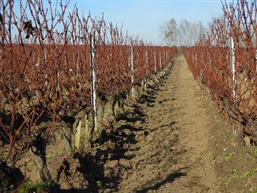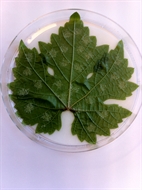


M.I.B.
Molecules with Biological Interest
The research activities of the MIB (Molécules d’Intérêt Biologique) group are organized along three main axes:
1. Analysis of grapevine and wine polyphenols
2. Study of these compounds in relation to the defence of grapevine towards diseases
3. Impact of these compounds on Human Health
1. Analysis of grapevine and wine polyphenols
|
|
|||
|
Grapevines and wines are a particularly good source of polyphenols. Their isolation and identification represents a major scientific challenge to which the MIB group aims to contribute. We characterize different families of polyphenols from grapevine and wine like anthocyanins , flavanols, flavonols, or –specially- stilbenes. For several years, our efforts have also been directed towards the development of new methodologies of analysis and production of these compounds, mainly by using Centrifugal Partition Chromatography (CPC) and Liquid Chromatography, frequently hyphenated with Mass Spectrometry and NMR. Our research contributes to a better characterization of the stilbenes and other polyphenols found in the grapevine and the wine. Additionally, our work allows us to obtain high amounts of pure molecules or extracts that can be used for biological studies in the laboratories of the MIB or in collaboration with other partners. On the other hand; in coordination with the VRAI project, we evaluate the feasibility of using the stilbenes as markers of wine authenticity. |
  |
||
|
|
Study of these compounds in relation to the defence of grapevine towards diseases
Grapevine can be affected by multiple diseases that can influence the yield production and the quality of the final wine. Nowadays, the common control of pathogen agents relies on the massive utilisation of fungicides. In order to reduce the abuse of phytosanitary products in the vineyards, the development of alternative strategies of plant protection should be addressed. Our strategy prioritizes two approaches:
1) the stimulation of the plant natural defence mechanisms by using elicitor molecules. The effects on the grapevine are measured by transcriptomics and metabolomics, especially in relation to the polyphenols (including the stilbenes).
2) The utilisation of natural compounds with antimicrobial activities. These molecules can be of major interest because of their diversity in mechanisms of action. We provide major interest to the polyphenols , like stilbenes , obtained from viticultural and oenological by-products or from the woody parts of the plant. We analyze their biological activity against certain plant diseases - mainly against mildew, but also against odium and against the grapevine trunk diseases. The impact of such treatments on the plant physiology is evaluated.
In both cases, we have verified the results of an improved protection against the grapevine major diseases, like mildew. In the context of a sustainable agriculture, these results can be extremely important, since they could lead to a reduction of the impact of pesticides use.
Besides, and by using grape cellular cultures, we can 1) infer the signal pathways and understand the action mechanisms of environmental factors (nitrogen, phytohormones, elicitors) and 2) produce biotechnologically polyphenols of interest.
1) the stimulation of the plant natural defence mechanisms by using elicitor molecules. The effects on the grapevine are measured by transcriptomics and metabolomics, especially in relation to the polyphenols (including the stilbenes).
2) The utilisation of natural compounds with antimicrobial activities. These molecules can be of major interest because of their diversity in mechanisms of action. We provide major interest to the polyphenols , like stilbenes , obtained from viticultural and oenological by-products or from the woody parts of the plant. We analyze their biological activity against certain plant diseases - mainly against mildew, but also against odium and against the grapevine trunk diseases. The impact of such treatments on the plant physiology is evaluated.
In both cases, we have verified the results of an improved protection against the grapevine major diseases, like mildew. In the context of a sustainable agriculture, these results can be extremely important, since they could lead to a reduction of the impact of pesticides use.
Besides, and by using grape cellular cultures, we can 1) infer the signal pathways and understand the action mechanisms of environmental factors (nitrogen, phytohormones, elicitors) and 2) produce biotechnologically polyphenols of interest.


3. Impact of these compounds on Human Health

Several studies have reported that polyphenols could prevent the development of several pathologies (cardiovascular diseases, certain cancers and neurodegenerative disorders) which share the presence of metabolic perturbations like the accumulation of free radicals (oxydant stress) or the chronic activation of inflammatory processes. It must be noted that many polyphenols are only slightly bioavailable and that, after consumption, they are found in the systemic circulation under different forms, mainly glucurono- and sulfo-conjugated.
We are interested in the biological activities of the native molecules from the plant and the wine, but also in the bioactivities of their circulating forms (metabolites which can be produced by hemisynthesis). We aim to evaluate the antioxidant , antiinflammatory and cytoprotective activity of stilbenes in in vitro experiments using cellular cultures, as well as the study of the polyphenols/biomolecules interaction by NMR.
We are interested in the biological activities of the native molecules from the plant and the wine, but also in the bioactivities of their circulating forms (metabolites which can be produced by hemisynthesis). We aim to evaluate the antioxidant , antiinflammatory and cytoprotective activity of stilbenes in in vitro experiments using cellular cultures, as well as the study of the polyphenols/biomolecules interaction by NMR.




